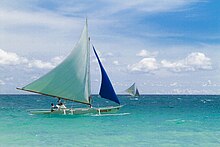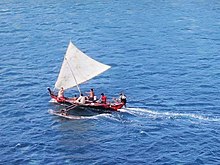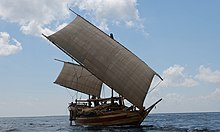Casco (barge)
Cascos are flat-bottomed square-ended barges from the Philippines. They were used mostly to carry cargo along lakes and rivers, and as lighters to transport goods to and from moored ships.[1] Though they resemble the Chinese sampan, they are much larger with two detachable masts with junk rigs made of woven fiber. They also possess outrigger-like platforms along the entire length of the sides, which is used by punters with barge poles when traversing shallow water. They were steered by an oar or a central rudder by a helmsman housed in a small raised platform at the stern. The entire deck is covered almost entirely in removable curving or pitched panels.[2][3]
Cascos were most prevalent in southern Luzon, particularly along the Pasig River and Laguna de Bay, as well as in the Manila Bay harbor.[2][3] In the late 18th and early 19th centuries, they were often strung together in a train drawn by a steamship (vapor). They were used as transport ships by American troops in Laguna de Bay during the Philippine–American War.[4] Cascos are still used today in fluvial parades. An example is during the celebrations of Our Lady of Peñafrancia in Naga City, Bicol.[5] [6]
-
Casco (foreground) in Manila (c. 1900)
-
Drawing of a casco (c. 1906)
-
A casco in Manila Bay in full sail (c. 1906)
-
An 1855 woodcut with a casco (left) in a woodcut on the entrance to the Pasig River from the Manila Bay
-
A casco with two punters (1873)
-
Vista del Puente de Manila, an 1847 painting by José Honorato Lozano showing a casco (center left) and several sampans and other river boats
See also
- Balangay
- Garay
- Guilalo
- Junk (ship), sailing ships of China
- Karakoa, raiding ship of the Visayas
- Paraw
- Salambaw
- Sampan, the Malay and Chinese version of the Casco
References
- ^ Ricardo E. Galang (1941). "Types of Watercraft in the Philippines". The Philippine Journal of Science. 75 (3): 291–306.
- ^ a b John Foreman (1906). The Philippine Islands: A Political, Geographical, Ethnographical, Social and Commercial History of the Philippine Archipelago embracing the Whole Period of Spanish Rule with an Account of the Succeeding American Insular Government. Hazell, Watson and Viney, LD.
- ^ a b Campbell Dauncey (1906). An Englishwoman in the Philippines. E.P. Dutton & Company.
- ^ Arnaldo Dumindin (2006). "Philippine–American War, 1899–1902". Retrieved 1 July 2018.
- ^ Insight Guides Philippines. Rough Guides UK. 2018. ISBN 9781786718563.
- ^ Jagor, Fedor (1873). Reisen in den Philippinen. Berlin: Weidmannsche Buchhandlung.











